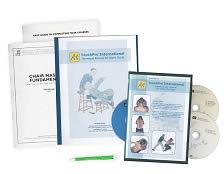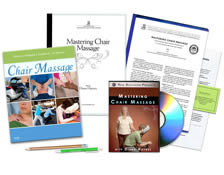 Want to earn continuing education credit for this article? Learn more.
Want to earn continuing education credit for this article? Learn more.
As more massage therapists do outcalls (bringing their tools of the trade to the client), they are also experiencing more injuries related to the improper handling of equipment, as opposed to injuries related to errors in body mechanics while administering the massage itself.
Preventing Injury
- Buy a massage table or chair that is comfortable to carry. These days portable massage tables and massage chairs come in all sizes and weights. Even the top weight of 38 pounds for a portable massage table sounds light enough when compared to a permanent table weighing in at the very least, well over 100 pounds. But when you have to carry it around, in and out of cars, up and down stairs, a few pounds can make all the difference in how you feel at the end of a day. The lightest portable massage table weighs just over 20 pounds. You need to balance the weight of the table with what you need in the way of size and sturdiness to accommodate your clients and the modalities you most frequently use.
- Have the client prepare an adequate space before you arrive. You shouldn’t be responsible for having to move heavy furniture out of the way to create enough room for your massage table or chair. When the appointment is made, make it clear to the client how much open space is needed. Create an outcall specific brochure with guidelines as to what is required as far as space and privacy.
- Make sure whatever transportation you use has ample space for your massage table as well as other accessories, including bolsters, linens and music player. Trying to get a massage table or chair out of the back seat of a two-door car or small trunk can wreak havoc on your back and nerves. You should be relaxed before giving a massage, not frustrated from trying to dislodge equipment stuck behind your spare tire.
- Use a wheeled cart for transporting your table. A massage case is nice for protecting your table against rips and tears. The handles and shoulder straps may also seem convenient but, unless you are walking short distances, you may find yourself with shoulder and back pain from carrying the table. A wheeled cart will allow you to move your table and accessories with ease. Most massage chairs come with wheels and a case that accommodates using them for easy transport. Save your body’s upper strength for the massage.
- Check with the client beforehand with regard to access to the home or office. Is there a clear path? Are there lots of steps? Is there an elevator? Is there parking nearby, or is there a long walk from a parking lot? Is the client in an urban, suburban or rural area? Knowing these factors in advance will give you an indication of how easy or difficult it will be to get your massage table or chair to the location of the massage. If there is time, you may want to make an advance visit to see accessibility for yourself.
- Stretch and exercise. As a massage therapist you do develop a lot of upper body strength, but this is not always enough to protect yourself against injury or strain with regard to carrying around a portable massage table or chair. There is a tendency to use one side more than the other when carrying heavy items, which may leave one side more strained. Make sure to stretch and strengthen both sides of your upper body, as well as strengthen both legs so as to avoid undue strain on your back.
- Schedule regular massages – for you. You would probably recommend this for your client if he or she had similar job requirements. It is not an indulgence, but a necessity for keeping your body and mind in optimum condition.
- Make sure your massage table or chair is in good working condition. Check cables, joints and screws regularly to make sure everything is tight and not frayed or split. A piece of equipment that collapses as you are working can cause not only great harm to your client, but to you as well.
- Always take a charged cell phone with you. If you have problems while traveling to a client you can call ahead and notify him or her, and even call for help if needed.
- Make sure someone knows where you are going, when you are leaving and when you are expected back to your office or home. Call when you arrive to let him or her know the name and address of the client and the approximate end time of the appointment.
Providing onsite or outcall massage to your clients is a great service. It allows you to accommodate those who may be disabled, who have a busy schedule, or who are homebound for whatever reason. But being in an unfamiliar location also allows for the possibility of more accidents resulting in injury. Following these safety tips can reduce the chance of injury or harm to both you and your clients and provide for a safe and lucrative outcall business.
Earn continuing education credit for this article contained in our Benefits of Onsite Massage series. Click here to enroll.













